[Note: The story below was shared by BikePortland subscriber Shawne Martinez, who goes by @tigard_stripes on Instagram. I’ve been away from Portland for a week dealing with my dad being in the hospital, so I’ve been unable to do BikePortland stuff. I’ll be sharing a few guest articles this week and until I can get my dad stabilized. Much love and thanks! – Jonathan]
I’m a carfree bike dad in Tigard, Oregon. My daughter Eliza (a second grader) and I put many miles on our bikes in Washington County and we often see and hear the WES train rolling between Tigard and Beaverton on our bike rides in Washington County. The WES, short for Westside Express Service, is a commuter train that runs between Wilsonville and Beaverton that can be beneficial for people living a car-lite (or car-free) lifestyle.
The limiting factor for us has been its schedule: weekday morning and afternoon rush hours only. With no weekend service we’ve found it difficult to utilize this train route. Recently, my kiddo’s school had a weekday break, so we decided to take our bikes on the train to Wilsonville. There are five morning departures from the Tigard Transit Center, then a six-hour gap until the first afternoon northbound train.


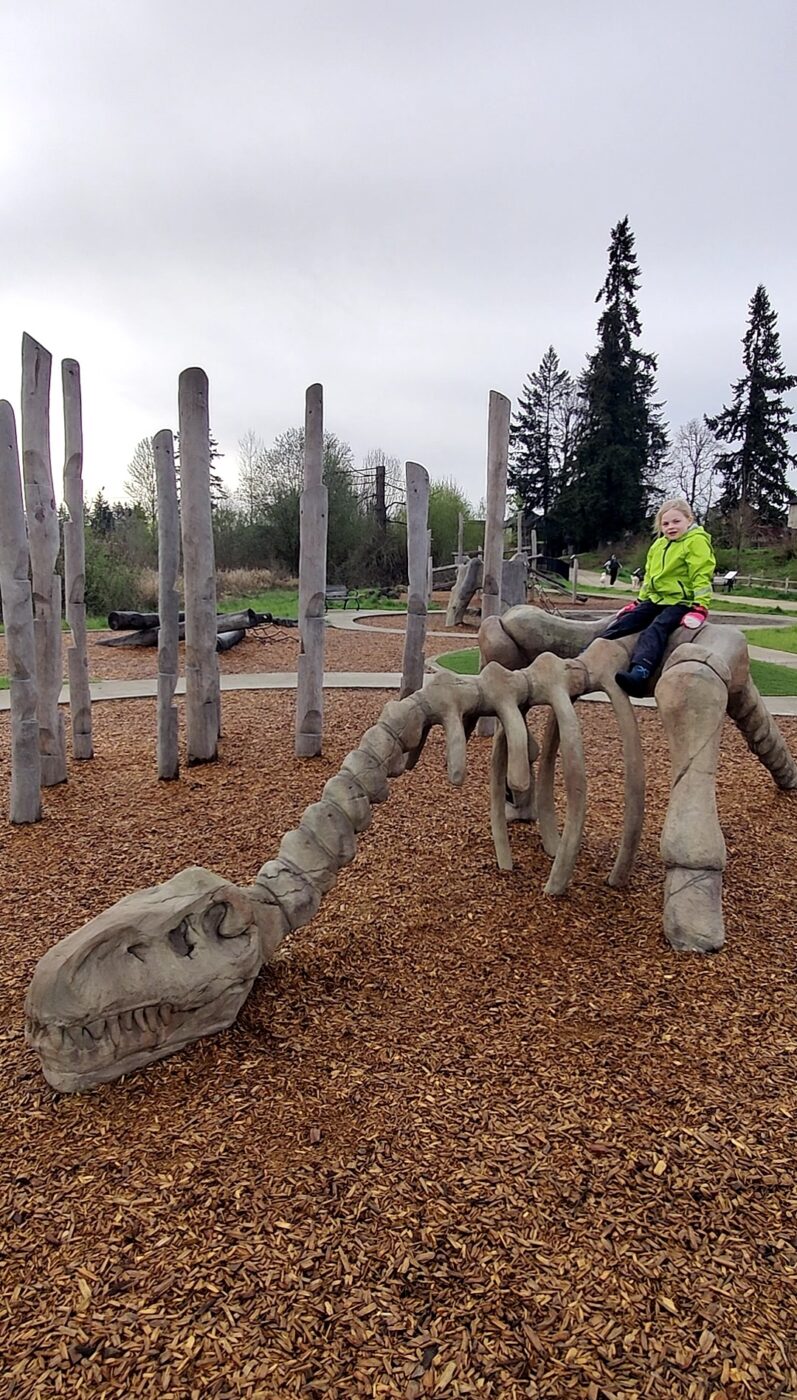
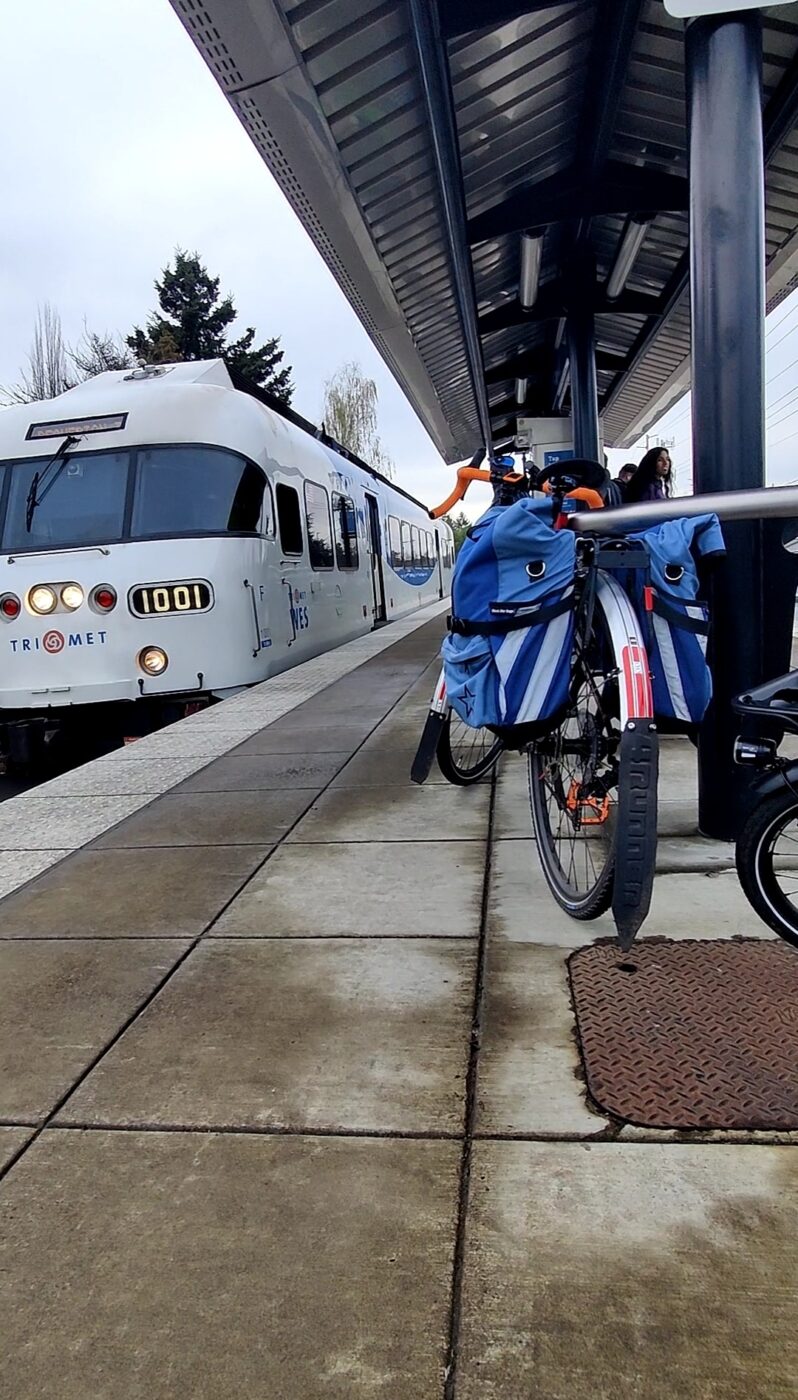

I needed to make this a fun experience for my 8-year-old daughter so I scanned the map near the Wilsonville Transit Center for bike infrastructure and fun activities. I spotted the entrance to a multi-use path just a couple of blocks away from the WES station with several playgrounds in the area. So we grabbed our bikes and rode the 1.5 miles to the Tigard Transit Center.
Boarding the WES with bikes is easy — just roll up the ramp up to the boarding platform and be sure to scan your Hop Card, phone or bank card at the scanner to pay your fare. While waiting for the train, there is an interactive sculpture at each station to keep people (young and old) busy. The train floor is at-grade with the station making for a smooth transition to roll the bikes on-board. There are a couple of wall mounted bike hooks that you can use or just park in the designated area and secure your bike to the wall with the provided strap.
So how’s the ride? This train is fast! We were in Wilsonville in no time. On the multi-use path near Coffee Lake Drive we discovered playgrounds, parks and a bird watching activity spot. We rolled to Lowrie Primary School to see their wind generator and rain garden sculpture. This community has an interesting mix of housing and street designs. Biking down Wilsonville Road we spotted several lunch options and stopped for a slice of pizza. We rolled under I-5 to see the paintings titled “Beauty and the Bridge” that surround this extremely loud and unpleasant section of our route. But our goal was in view: another path that would lead us to Bulwinkle’s Family Fun Center! (The bike racks at Bulwinkles are hidden around the right-side of the building. Why not right by the front door?) A putt-putt course, video games and bowling kept us busy for a couple more hours.
Car traffic on I-5 was completely stopped as we rolled back to the Wilsonville Transit Center just in time to board the 3:30 WES train back to Tigard. The doors closed just as we rolled on (whew!) We enjoyed a quick 18-minute ride back to the Tigard Transit Center. Although we’ve taken the WES to Beaverton several times, this was our fist time riding to Wilsonville. It was a positive experience, and the kiddo had a blast.
It just proved to me once again that public transit is the ultimate range extender for bikes and a great way to leave the car at home.
Read more of Shawne’s transit and cycling adventures here.


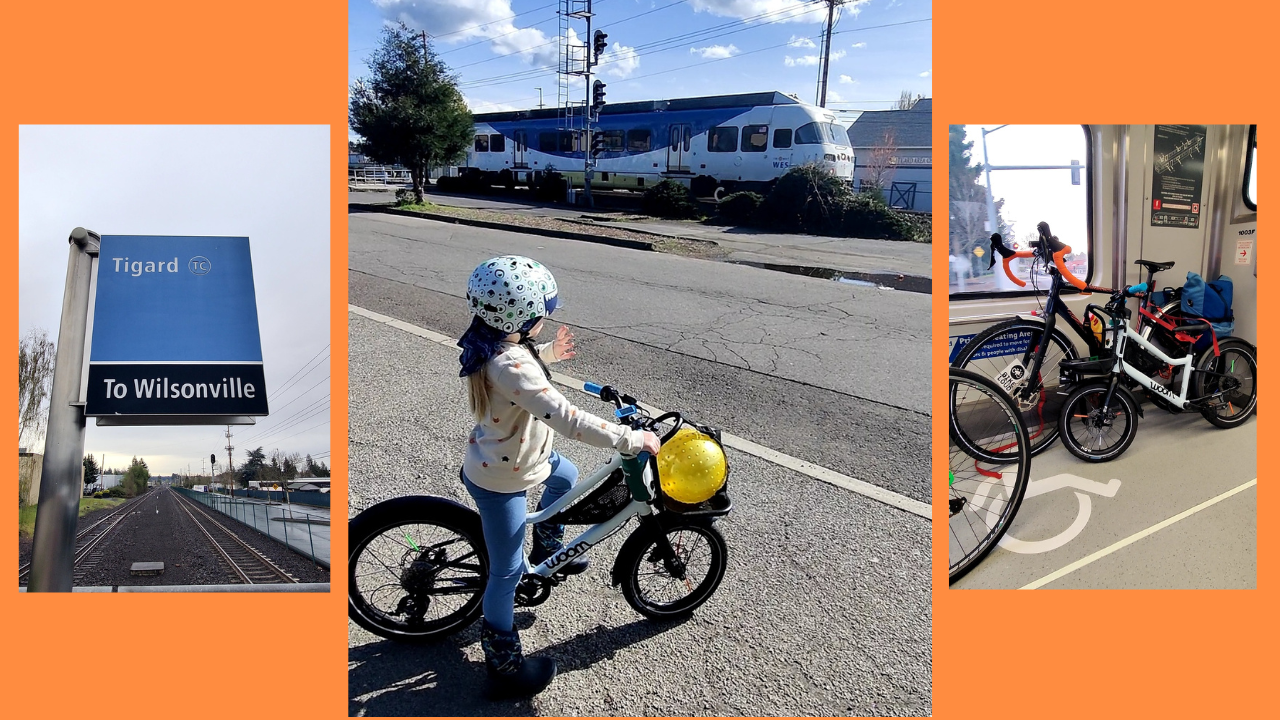
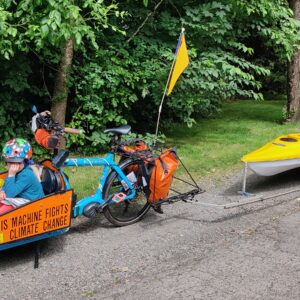
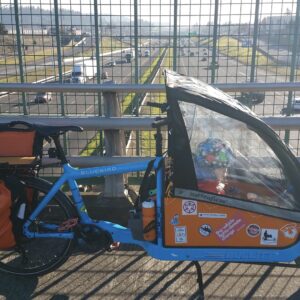
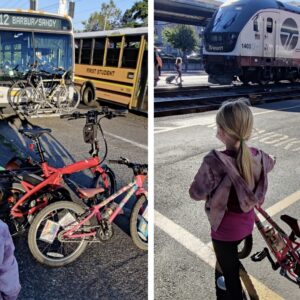
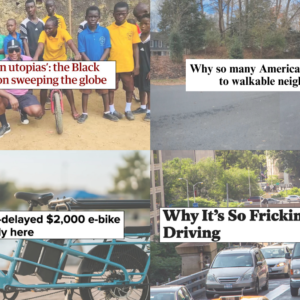
Thanks for reading.
BikePortland has served this community with independent community journalism since 2005. We rely on subscriptions from readers like you to survive. Your financial support is vital in keeping this valuable resource alive and well.
Please subscribe today to strengthen and expand our work.
Best wishes to your dad in the hospital, JM.
As for the WES train, I took it many years ago, when it was new, from Tigard to Wilsonville and back. Of course I loved it but I also lamented the missed opportunities: why does such a capable train go such a short distance and serve only outlying spots? The destination in Wilsonville – an office park far from Wilsonville center – is not all that useful. Likewise, if you are south of Portland and want to go to Portland, why do you end up at the Tigard Transit Center and have to take another 40-minute MAX ride downtown?
The WES train is a metaphor for public transit and bike infrastructure, in the Portland Metro region, in the following ways:
What is really needed is fast train service to downtown Portland, and points in between, from the south, and unfortunately WES ain’t it – nice a train and service as it is.
The transfer to MAX is at the Beaverton Transit Center, so you can get both to downtown Portland or out to Hillsboro. It was conceived as a commuter rail to get people to work so morning and evening trains and stops near connections to job centers. In any case, sharing the freight line makes a more regular schedule all but impossible.
Someone called it “urban jewelry” when it was built and to some extent that is still true. People like the idea of it being available more than they actually use it. That doesn’t mean it doesn’t have value, but you aren’t going to measure the value solely by ridership.
I heard an argument for changing the Northern terminus from Beaverton to Portland to gain ridership. I wonder if that would work.
It might, but I don’t know if they can run diesel trains in the Robertson Tunnels
Tax the rich* and build electrified commuter rail surrounded by social housing.
.
*including developers, landlords, and other housing speculators
I mean sure, but that wouldn’t solve the problem with the WES, which runs on non-electrified private freight rail ROW.
Painfully accurate. Though I’d add this bullet:
Activists get to scream and howl when any attempt at revising the poor implementation is made, framing it as an attack on their identities, their communities, the environment and their very lives!
I also did a bike + WES adventure but from Beaverton to Tigard recently. Minus the kid though, lol.
I think it’s a great alignment and has so much potential if they’d just run it more often! Plus it’s got good connections to bus lines and MAX in Beaverton. I know they share tracks owned by Portland and Western. Does anyone know any technical and/or logistical solutions to running it more frequently? Trains every half hour for most of the day would make it so much more practical and probably up the ridership.
Or I guess ODOT could just widen 217 again in 8 years :/
Right now it costs TriMet about $100 per passenger to run WES (an unbelievable sum), almost all of which is subsidy. Would running it every 30 minutes increase ridership enough to make it worthwhile?
If you doubled the number of passengers (for example), and that lowered the cost to $85 per passenger, you’d still need to come up with a lot more money to operate at the increased tempo.
You do make good points. I think the schedule is really what’s killing the ridership potential. Perhaps they could take the current trains and spread them more evenly throughout the day? Then, if ridership improves they could run more trains.
It strikes me that the primary limit is the number of people who want to take transit between Beaverton and Wilsonville. I can’t see how a dedicated heavy rail line could ever make sense in that context. You’d need a gargantuan increase in ridership without any increase in cost to even get down to the Max subsidy level.
The money we’re spending on WES would be much better spent on other transit service. Its a money pit.
From memory, part of the eye-popping per-ride subsidy is due to federal regulations that require a conductor on every WES train. The doubles the labor cost while providing no improvement to the service itself.
A conductor can’t be the sole reason for the eye-popping cost; the subsidy for one passenger would cover that cost, but it’s another reason why heavy rail doesn’t make sense for this route. That said, I think Max would have more ridership if there were a conductor on each train that could maintain order.
Please see my comment above about how WES doesn’t go where most people need to go.
We need transit to be BETTER than I-5 and 217 and 26 – it needs to compete directly. But it doesn’t. So the options we are left with just don’t attract enough passengers.
To compete directly, transit would need to pick you up at your house when you’re ready to go, and deliver you to your destination in a reasonable period of time, at a low cost, and make it easy to carry a load of stuff like groceries.
It works well for some trips, but mostly not (as revealed in TriMet’s ridership numbers).
Not advocating for the status-quo, just pointing out the obvious.
Do I-5, 217, and 26 start at your front door? Of course not. Transit competes with driving by enabling more efficient land use, so people don’t need to go 10 miles to get to the grocery store.
The road network does start at my front door, yes. And probably yours as well.
If there were a reliable bus that came when I wanted to go and would take me to within a few blocks of my destination relatively quickly, and could then get me back home, perhaps with a stop at a store along the way, I’d likely take it, even if it were more expensive than driving.
I’m pretty well served by transit, but this situation doesn’t exist for me for any trip long enough that I wouldn’t just ride my bike. If it works for you, that’s great.
My comment was about the demand for highways, not the road network (or street network) in general. The point is that transit enables greater density of mixed land uses so people have more potential destinations close by without necessarily needing to use transit (or a car) at all.
The limitation is the number of trainsets more than the traffic on the line. They had issues with the initial rail cars (the manufacturer went out of business). Ultimately, they could run more service, but the subsidy per rider is pretty eye-watering currently.
We definitely need more choices than driving single occupancy vehicles on 217 and Hall Blvd. Frequency and safety are important factors!
How about a van service?
Micro transit is a social service, not a transit service. If it’s a struggle to get mass transit to pan out, then “min” transit is simply impossible.
WES costs $100 per passenger. You could give each rider an individual taxi ride directly to their final destination for (much) less than that.
If you do it using EVs, it would almost certainly emit (far) less CO2 than running heavy rail. Even gas cars would likely emit less. Vans would certainly do so.
Better service, better for the environment, cheaper… seems like a winner on all fronts.
The combination of trains and bikes is ideal, since you can trivially go at least a couple miles by bike, it’s easy to be in range of a train. The usual “last mile” problem is solved. I wish there could somehow be a max line that stopped at about 1/10th of the stops (making up numbers) so it could be faster, but obviously that conflicts with the nature of trains.
I’ve done something similar to go out towards Beaverton (from Portland), and it’s pretty nice, especially for crossing those hills.
An express MAX train is an interesting concept! It may require an additional track in places.
I really want TriMet to run WES between Tualatin and Portland via the existing P&W/UP tracks that run through Lake Oswego and Milwaukie. They already have a working relationship with P&W, and it would somewhat compensate for the lack of MAX in that area.
From where I sit, the WES is the poster child for Metro Portland’s half-hearted attempts at transit people want to use, and its willingness to actually change its–especially-suburbs to be more vibrant, denser places. Far and away the biggest part of the problem is the continued use of west suburb city centers by the freight line.
There is no business, in the 21st century, for a supposedly progressive region to be running diesel freight trains in what should be the middle of city centers. They’re loud, they’re slow, they’re polluting, and they dramatically decrease the desirability of these areas to developers, businesses, and residents. I’m still waiting to see if the FRA quiet zone passes for Beaverton, because they’re building a large apartment block right next to where the line diverges from the segment the WES operates on to head west, and there’s no way that people will want to live immediately adjacent to where the freight train runs and blasts its horn at regular intervals, day and night.
If we lived in a more sensible country that actually valued efficiency, the freight line would be rebuilt way out through farmlands west of central Tualatin, Tigard, and Beaverton, so that these city centers would be desirable places for people to live and work, and the MAX would be extended south to Wilsonville. Pair that with a city center MAX tunnel to expedite travel throughout the entire system, and all of a sudden, you have a trio of suburban cities with hospitable, easy access to the entire region which the MAX serves.
Yes! Until leaders put transit on a par with driving, transit will always play second fiddle.
I didn’t know anything about the noise and pollution issues so thanks for bringing them up (though it seems a bit odd that no one stops a road, with noisy and polluting trucks, for those reasons?).
The horn blasts from the freight train are on an entirely different level. There’s a minimum specified 2-long, 1-short, 1-long horn at every grade crossing, but there’s no specification of the duration for each, and having lived within a block of a grade crossing for 4 years, I can vouch that it ends up being a lot of noise for a long time, at each grade crossing, of which there are 5 in barely a mile through central Beaverton. And this is supposedly up to 110db, though it feels–literally, feels, it’s so loud–like more.
It’s just too much for what ought to be the heart of the town. I hold the engine noise/pollution against them far less, considering they’re ultimately less polluting than the freight trucks in the area, and ideally more freight should be on the rails, but…not here. Pair that with the compromises they necessitate for the WES service (less frequency, and obviously unelectrified, as American freight railways are apparently allergic to overhead wires), and there’s no excusing not working with landowners out in the countryside to get the freight trains out of this area.
Unfortunately, WES and MAX are fixed systems that have no flexibility and with TriMet’s lack luster maintenance record (shall we say no maintenance) they break down often.
Seems that going with more flexible buses, with longer ones that can work in many areas, the train system(s) are just going to continue to put our tax money in overpriced (but high profits for the construction companies of course) options that really don’t get passengers where they want to go quickly and safely. I’ve tested and I can drive from downtown Portland to my house in much less time at rush hour than it’s ever taken for me on the MAX. My co-workers tell me I’m crazy to keep riding, but I do.
I wonder how many buses and drivers could be running now on the streets of the region if the same amount of money that’s been wasted on WES and MAX had been properly spent on something useful?
We can all thank Goldschmidt for leading the way, to making his buddies very rich at the region’s expense.
Cost: The per-passenger subsidy of Max is only about 10% higher than for buses, if memory serves, which means that converting to bus service wouldn’t save all that much. WES is a completely different story.
Time: For most trips, driving is simply faster than transit, and a brisk cycling pace is faster than the average bus speed. For any trip that I would not walk or bike, transit is significantly slower, more expensive, and less comfortable than driving. I do not think that can be fixed without rethinking how transit fundamentally works.
Again with your nonsense, “reinvent transit” line. No, we need bus-only lanes–not our BS BRT-lite-lite “FX”; we need a city-center MAX tunnel; we need actual, concrete-curb-protected bike lanes (not sharrows or bike lanes that are just shoulders). We need to do what every other successful city does with its non-car transit modes: actually prioritize it.
And then, we need to show a willingness to redevelop–privately or publicly–the areas served so that people want and need to get where it goes.
We don’t need to reinvent the wheel, here; we need to do what other places have already shown works.
Agreed; we just need to rebuild everything.
Your ideas on transit would make it some trips speedier (which is good), but don’t address the more fundamental problem that a huge number of origin-destinations that people want are basically “untransitable” in a world of finite resources (without lengthy trips), a problem that is growing worse as fewer people travel downtown daily.
Look, I’ll support any reasonable transit proposal, as I always have. If your vision for the world materializes, that will be great, but I don’t think it will. The many empty buses and trains I see as I travel around Portland suggest transit doesn’t work well for most people most of the time.
My prediction is that the way transit works will change before society does, but I’ve been wrong before.
At this point, I expect neither to change; our transit won’t get better, and, despite all the beneficial and obvious reasons for dense redevelopment (again, private or public) on a massive scale to get transit to work (housing cost control, the environment, urban agglomeration economics), I don’t expect it to happen, either. However, it has happened before, and could happen again.
There’s no reason for you to poo-poo every article or comment on here proposing how it could be made to work, just as there’s no reason for me to need to ra-ra every comment in response. But I don’t understand why someone of your apparent ideological leanings is even here; if you think only electric robotaxis will save us, you’re unsurprisingly probably not going to sympathize with most of what BikePortland posts.
I don’t want to make this personal, but your consistency in this direction is frustrating (much as I’m sure mine in my direction is annoying).
Do we actually disagree on much?
We agree that cars are dangerous and polluting, and that if we’re going to get through the next 30 years, something has to change. We seem to agree that conventional transit won’t “save us” (though I hate that phrase), and we mostly agree on why. We both generally agree it would be possible to construct a city where transit was the main way to get around, and we seem to agree that retrofitting such a system of landuse and transportation onto our existing city would be very difficult and expensive, especially if a critical mass of residents opposes doing so (as they currently do).
Where we differ, primarily, is that I see hope for a new paradigm that might actually allow us to reshape some of the currently intra table things that neither of us likes about the city. That’s not really much in the scheme of things.
On what other points or values do we actually disagree?
I’m not who you asked, but how are self driving cars going to fix anything, assuming they ever actually exist (this is uncertain)? What is the paradigm shift? They’re going to make the same traffic or worst. They don’t address any of the sprawl. They’re just as noisy. They’re an environmental problem. They just don’t seem to actually help with anything.
The paradigm shift they offer is essentially individualized transit that can take you point-to-point on demand. They might make traffic worse, or they might not, that remains to be seen. (Vehicles could get smaller, become better coordinated, etc.)
But if they work, they automated vehicles the potential to address all forms of dangerous driving (drunk, drugged, and distracted driving, speeding, etc.), the need for urban parking, and perhaps even the cost of car ownership. Reducing the need for parking has obvious benefits, allowing the more compact landuse that make walking and biking easier.
Dynamically routed/scheduled buses and vans might also be feasible, and trunk transit, like Max, would probably still make sense.
I agree that there is no guarantee that automated vehicles will work or be widely deployed (but the fact they are in actual use in multiple cities gives me confidence the technology will continue to get better — I see no fundamental limits to its improvement).
I see no realistic prospect for addressing the issues listed above any other way, just as we haven’t managed to fix them over the past century. If transit gets us there first, that would be great too, but I have high confidence buses won’t become dominant in American cities in my lifetime.
Here’s a key point. Over the past century, we went from problems related to transit already being basically fixed, and have progressively made it worse. The problems we have now didn’t exist a hundred years ago, it doesn’t make sense to talk about whether we fixed them over the last hundred years. We created the problems in that time!
It may not be possible to fix these problems in your lifetime, I agree. Maybe we should not be obsessing about things that we personally are going to see in our lifetimes and instead think about long term. I know our personal ego dies when we die, but we’re capable (at least some of us) of having compassion and caring for future people. And for future people, the meager and possibly non-existent benefits of self driving and electric cars (even through the most optimistic lens) aren’t going to make much difference. But mass transit can. To support current population (much less a growing one!) we can’t keep sprawling out and expect that to be anything sustainable.
You often talk about how our infrastructure is already built. It exists and we’re stuck with it. I just don’t see it that way. Not only can anything we built over a hundred years be rebuilt in another hundred, but on a shorter timeframe, we could do things like increase density. Because of various artificial constraints, it doesn’t seem to “pencil out” to build dense housing in downtown, but the demand is there. People want to live there, housing is expensive. So if we found a way to get rid of those artificial constraints and actually build affordable housing in town, people would move there. With enough density (and it doesn’t take much, even converting single family homes to 2-4 unit town homes would make a huge difference), a lot of the problems just start to go away.
But I’m digressing. Just talking, bla bla. I’d like to see a future where people actually live in the city instead of this diffused mess. We could get there. We probably need collective or state action for it to happen (i.e. subsidized or public housing), and the previous red scare has made that hard.
I’m really not sure how you can be confident that “future people” will want to get around by bus, or live in cities much denser than today (a lifestyle you yourself have chosen not to live).
But regardless, as I’ve said before, I’ll support any sensible transit project, as I always have, so I’m not really your opponent in this regard. If enough people want to start building now for future people 100 years hence, we will (even if it requires a ballot initiative).
I live in the city I live in today because humans are not, in fact, free rational perfect economic consumers, doing everything according to maximum utility and profit. I was born here and any opportunity to move, I have moved closer to the city center, but haven’t ever really had an opportunity or desire to uproot and move away from family and friends. New York City would be a good option otherwise, and clearly a lot of people want to live there too.
I know people will (and currently do) want to live in denser areas because those areas are already in high demand. All the places that are walkable and conveniently bus-able are already too expensive for many people to live in and that expense is a factor of demand and unnecessarily restricted supply of housing. We have many examples of places that are arbitrarily close to a walkable mass transit utopia, and they are not fundamentally different from this area in any way.
On that note, I’d be curious to know how New York City (as an example) resisted the systematic demolition of its mass transit system like so many others.
I wasn’t referring to NYC, but rather a single family house, and I did not at all mean to suggest that people don’t want to live in areas with many amenities. That’s obviously false. Not everyone does, but many do.
The areas in highest demand are the close-in single family houses. It is both because they are near other things, but also because they are single family houses, and not apartment blocks. People like you and me like to have access to a yard or a garden. I suspect “future people” will too.
Again, I think any disagreements we have are quite minor.
“We seem to agree that conventional transit won’t “save us” (though I hate that phrase), and we mostly agree on why. We both generally agree it would be possible to construct a city where transit was the main way to get around, and we seem to agree that retrofitting such a system of landuse and transportation onto our existing city would be very difficult and expensive, especially if a critical mass of residents opposes doing so (as they currently do)”
I disagree with several parts of this:
The challenge we have these days is in reminding the average person that the status quo is actually a radically new state of affairs in humanity’s long history, not a result of some set of natural processes over which we have no control, and more to the point have an incentive to change insofar as we can, in any case. The American city has been fundamentally reimagined before; there’s no reason to think that it couldn’t be again.
I’m not arguing that it can’t, only that it won’t. It would require us as a society to make fundamentally different choices than we have in the past, and invest considerable resources in reconstructing our cities. It will require us to change the way we live and give up things we value.
We could do all that, but we probably won’t.
So are antibiotics. New doesn’t always mean bad or that the way we did things for millennia are better.
I don’t oppose your vision — parts of it sound great, and if society wants to change, I’ll change with it. But do you really think it will? And do you see any evidence the change you imagine is coming?
You miss every shot you don’t take.
(I don’t want to hijack your thread, just saying)
A YIMBY-leaning person in the BP comments scoffed at my contention that even if this were to happen it would take many decades — a time line I argued is incompatible with keeping CO2e under 2 C. They insisted that we could reconstruct our cities into a high-density low-car environment (e.g. Utrecht) in a decade. This kind of magical thinking is ubiquitous in climate-adjacent movements. People really don’t want to think about what climate science indicates we need to do because it’s so much easier to instead dream fluffy dreams about the Utrechtization of Portland (in just ten years).
At this point, I think it’s impossible that we’re not going to just have climate catastrophe. Even the latest infrastructure bill went mostly to expanding highways; EV sales have at least temporarily plateaued to the point that lots of carmakers are just going back to hybrids; every country’s still subsidizing and consuming fossil fuels en mass. “The end” isn’t nigh, but any rosy scenario wherein we actually change things enough to avoid some of the worst consequences is almost certainly out of reach. Rebuilding our cities could be done quickly, if we let it; it doesn’t take but a few years to build apartment blocks. Nonetheless, we still have a large portion of the population that thinks climate change is a matter of belief or disbelief, and status quo bias is alive and well in most people, so it has always been a bit pie-in-the-sky, despite my own protests.
We needed strong and competent governments to fix this problem, and especially in the U.S. people don’t understand that government is just a useful means of social organization that could do things like, e.g., mass land appropriation to develop public housing. We’ve gotten the poor governance we expected, and unfortunately, we and the whole world are going to suffer for it.
In the kind of society we live in we would need to do more than just build apartment blocks, we would need to build the well-resourced neighborhoods that convinces the majority to give up the ‘murrican dream of a yard, fence, and garage.
A world at 2 C is a one with immensely less suffering and unnecessary death than one at 2.7 C. I think this scenario seems out of reach in the USA but other regions are making rapid progress. The USA may be pulled into decarbonization (kicking and screaming) simply because it depends on the global economy for much of it’s “consumption”.
Nor does new mean good, intrinsically. The point isn’t “new is bad”; the point is that “new” is as transient a condition as anything else, and treating what is now as unchanging–or unchangeable–is a similar mistake that doesn’t have a lot of support in history. Nonetheless, there are interests heavily vested in making how things are now seem like Everest climbs to change, when in fact, keeping things as they are now is at least as enormous an effort, requiring huge sacrifices that people don’t even think of themselves as acquiescing to. Bringing attention to that is important.
I don’t think things will change, but then, I also like to think that I’m more pessimistic than the average person. On the contrary, we seem to be as used to the mass deaths, huge personal expense, and global ecological costs of using cars as mass transit as we’ve ever been. What that means–to me–is that there’s no reason to defend the status quo, but rather a moral compulsion to point out the possibility–and necessity–for change.
I can’t generally even get people to listen to me in substantive ways in my personal life, so I don’t expect great masses to agree with my perspective, either, but I at least have to add my voice to the urbanist chorus that’s out there, even as it’s drowned out by other, contrary songs. I mope and groan as a moral exercise, because nothing I do–or don’t do–seems to matter as an expression of personal beliefs. But at least I can say I’ve done that.
This is a case where I can honestly say I feel your pain. We don’t develop or improve transit or active transportation at the expense of personal vehicle use because there’s a strong constituency for preserving existing levels of service for car movement and storage. An individual or a business can almost single handedly block a bike lane or bus lane.
What can one person do to push things in the other direction? They can adopt their local bike route or bus line. I don’t know that much about buses riders or bus routes because I mostly see them from the outside. I do know many people who use particular bike routes.
If five, or 50, people agree on a thing they and their friends can generate a volume of comment and complaint that can directly create change. As individuals we can create common cause with others in a similar situation and demand change. What if there were, for example, a Sandy Boulevard bus riders association?
There are few bikes on Sandy because it’s practically a freeway but there are a bunch of people gutting it out riding the bus. If those people are informed about any changes to Sandy Blvd they can become a vocal and visible constituency for bus priority on a street that crosses much of NE Portland on a diagonal route adjacent to I-84.
I happen to have an extended conversation with someone from the TriMet Riders Union (or whatever the main bus rider advocacy group is) a couple of weeks ago, and they lamented the reduction of lanes on Hawthorne from 4 to 2, and complained that they had seen a presentation by Sightline that was filled with manipulative language and asked why they don’t just make better arguments. While I agreed with their observations of Sightline, I found myself defending the car lane reduction and explaining some of the reasoning behind it. I don’t think I was successful at changing their mind.
I think the idea that everyone who uses a particular mode of transportation subscribes to a particular constellation of beliefs is false. I don’t know how they would have felt about your description of taking the bus as “gutting it out.”
It’s a chicken and egg problem. Transit doesn’t work because we don’t prioritize it. So people don’t ride it. So people like you point at ridership and say transit doesn’t work. It’s not a society problem, it’s not about personal preferences. Politically we (not everyone) have decided to make buses bad and then lo and behold, they’re bad.
About the untransitable problem – with time, not overnight, the places people want to go look like the network of good transit. It’s a symbiosis. Obviously, car culture has moved us away from that so you can’t imagine where the bus routes should go, but with time and short term fixes like bus lanes, express bus routes, more frequent service, things can move back in the right direction. It’s like steering a ship, nothing is going to fix this problem instantly.
Transit will never work in Portland as long as Trimet treats it (mainly the MAX) as an economic engine and not a means of transporting citizens from here to there.
The goal of transit should not be “flexibility”, since private automobiles will always win out in that area. Transit benefits cities by connecting walkable areas, not specific destinations. Transit enables greater walkability by encouraging more efficient land use in the area around transit stops. And until we smash capitalism once and for all, someone is going to get rich building the things we need, whether that’s trains or buses.
Unfortunately the tracks are owned by Portland & Western, whose trains have priority on the line. In a truly sensible country, e.g. Switzerland, the freight rail network would be publicly owned, electrified, and expanded to serve local businesses and reduce the number of trucks on the road.
Agree on nationalizing and electrifying railways, but do you have any source for the claim that WES isn’t given priority on the line? I’m having trouble verifying it either way, but I did find this old PDF from TriMet claiming WES has priority during commuter hours.
That’s interesting, I just assumed the arrangement was similar to Amtrak, where passenger trains have to yield to freight trains. Amazingly, it turns out that’s been illegal all along.
In fact you’re right, WES passenger trains are (at least supposed to be) prioritized over freight. That was my error.
Delays due to freight traffic are definitely not the priority problem for WES. It just doesn’t go to the places enough people want to go to attract large ridership. We could pay to run trains all day long and ridership would only tick up slightly.
The WES will always hold a special place in my heart. Right after college I was living in Tualatin and working out in Beaverton. I had done the car commute for about 3-4 months, but it was stripping away at my sanity to be sitting in the parking lot that is 217 (or whatever random street Google Maps routed me on). I switched to taking the WES and my mental health improved significantly (it also helped me to get into reading for fun). Biggest drawback was definitely the times that it ran. I often times still had to drive into work if I wanted to go into the city and do something fun after work. Eventually I moved into the city and haven’t ridden it since.